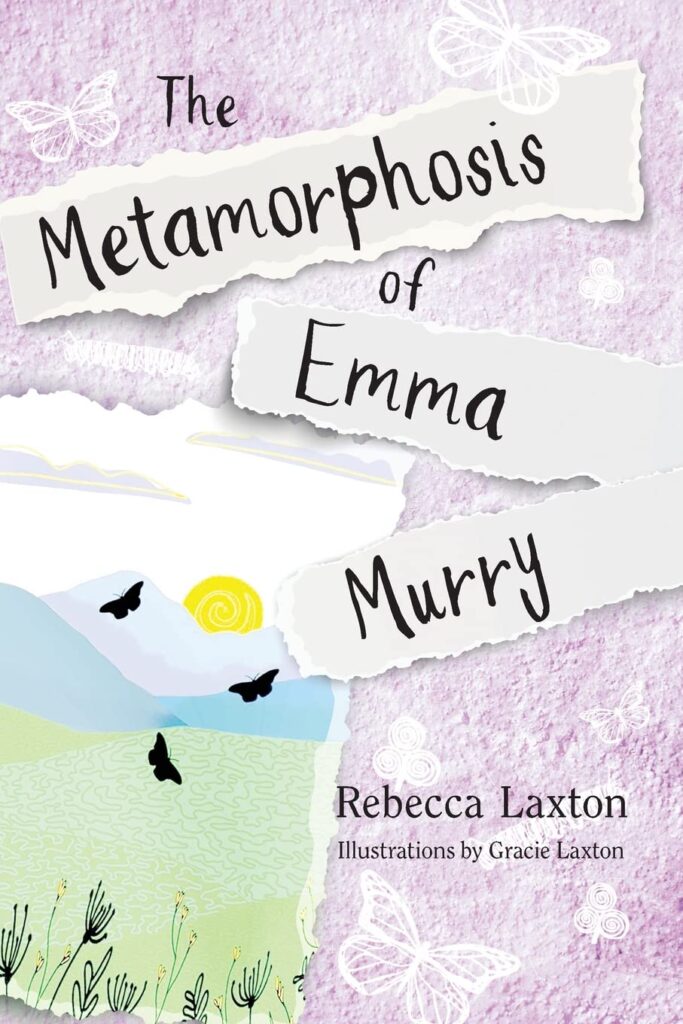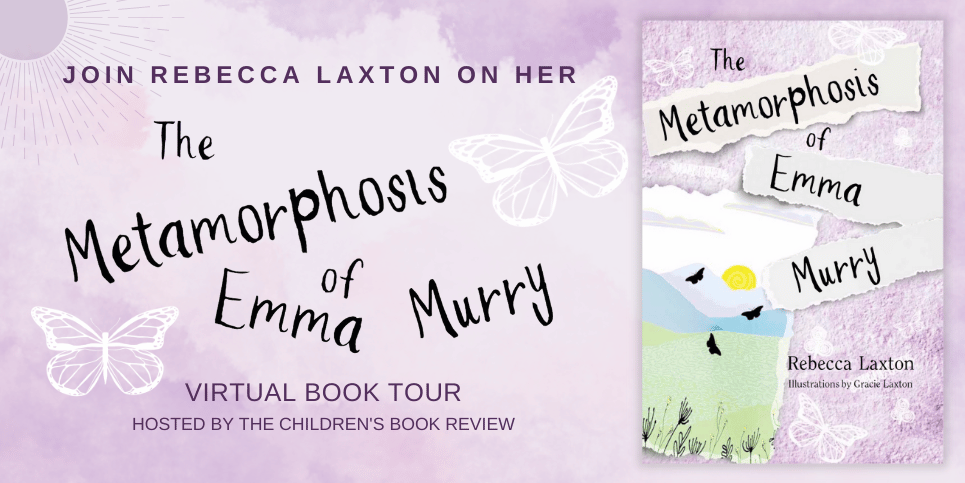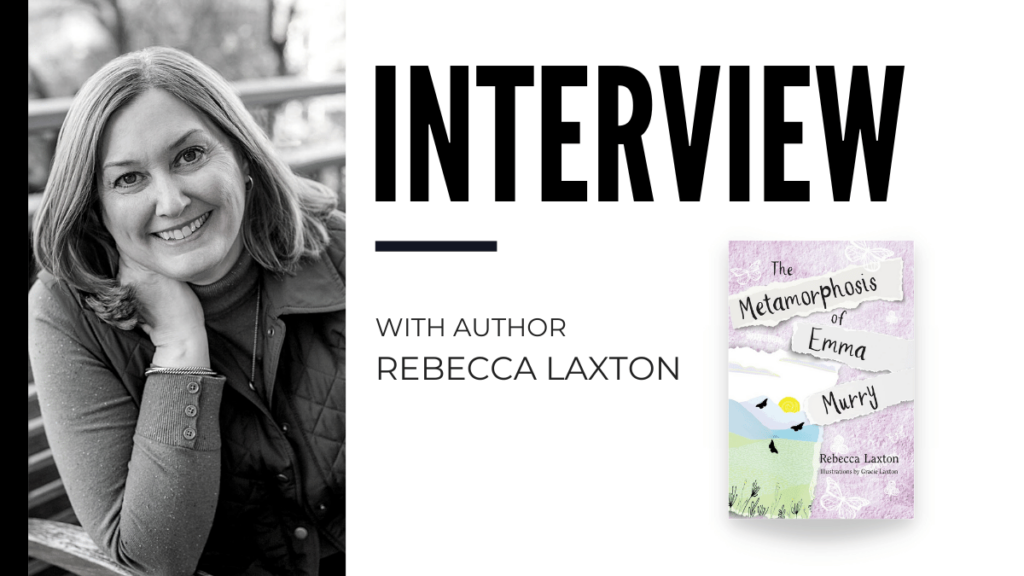An interview in partnership with The Children’s Book Review and Rebecca Laxton, author of The Metamorphosis of Emma Murry.
Rebecca Laxton has served school communities as an afterschool program director, reading specialist, and school psychologist. While working for Boone County Schools, she was named the Kentucky School Psychologist of the Year for collaborating with teachers and administrators to write and evaluate an emotional intelligence curriculum.
Rebecca is a member of the Society of Children’s Book Writers and Illustrators, Charlotte Literary Arts, and the North Carolina Writers Association. Her short memoir, “Throw Like a Girl,” about playing on a mostly boys’ Little League team, can be found in The Love of Baseball (McFarland 2017). Currently, she is a dyslexia practitioner and enjoys reading, writing, and spending time in the Blue Ridge Mountains with her husband, four kids, and three dogs.
In this interview, Rebecca discusses everything from activism and conservation efforts for young readers and healthy relationships with social media to her favorite childhood stories. And, of course, her riveting novel The Metamorphosis of Emma Murry.

What inspired you to want to write a story about activism for young readers?
Rebecca Laxton: The Kirkus review of The Metamorphosis of Emma Murry says that the book has a “laudable adolescent cast.” Which I think is such a nice thing to say about the characters who are a reflection of the Gen Z and Gen Alpha kids I see all around me—my own kids, their friends, my friends’ kids, and the kids I tutor.
These generations have grown up being able to engage with the world at a younger age in ways that previous generations were not able to, and this has created kids who are more empowered at a younger age than previous generations. I see them using their knowledge and connectivity every day to stand up for the world they live in, and I wanted to capture that phenomenon in a contemporary novel young readers could relate to.
Emma is such a complex, sensitive character. Is she based on a real person?
She’s not based on a real person, but she does feel very real. As a reader, there have been so many characters I’ve met in books over the years that felt real and seemed like friends, so I hope my readers have that same experience as they meet Emma.
Black Mountain also feels very real and is easy to fall in love with. Is it a real place or based on a real place? Or is it more idealized than that?
Black Mountain is a real town in Western North Carolina near Asheville, but the Black Mountain in the book is a fictionalized version of the town. My twins went to camps there every year from elementary school until the summer before their senior year in high school when it closed due to Covid. I chose to set my novel in Black Mountain because our family loves it there. During those camp years, we’d return to Black Mountain with them to visit the town and hike the trails they’d hiked over the summer as they relived their camp experiences by telling us stories of their adventures.
I wrote many of the book’s scenes after hiking the Kitsuma trail and sitting at the top of the mountain overlooking the valley, using real landmarks and creating others from my imagination. Other scenes were written after eating at restaurants, walking down the aisles of the General Store, strolling in and out of the town shops, and sitting on benches in town. It’s a beautiful place full of artists and nature lovers, and the whole area has embraced environmentalism, so it’s the perfect backdrop for my story.
Emma and her friends focus primarily on monarch butterflies in their conservation efforts. However, the story also makes it clear that sustainability is about caring for the environment as a complex whole. Do you think focusing on a single species like the Monarch is more helpful, or should readers think about sustainability more holistically?
With kids, I think it’s better to start small and with ways they can make a difference because it can be overwhelming. There are many things that kids can do to help monarch butterflies, just like the kids in the novel. For example, they can plant milkweed—monarchs only lay eggs on milkweed—and they can plant other native flowers so the monarchs can feed off the nectar. This not only helps monarchs, but other pollinators, such as bees, as well. So starting with monarchs segues into the holistic idea of global sustainability.
We need to protect pollinators because we need them for the survival of the human race and our planet, and teaching kids how to help pollinators is a very concrete way to introduce the idea that pollinator conservation not only protects beautiful little insects but also protects all of us.
I visited a school in Charlotte, North Carolina, recently where each classroom had a garden, and the school is a part of the butterfly migration highway. The kids knew a lot about pollinators and monarchs and were extremely proud to talk about their personal conservation efforts. They are making a difference, and this is very empowering for kids, and it will definitely lead to a continued interest in environmentalism as they grow older.
Emma’s interest in conservation starts with her deep love for her local environment and community. What lesson would you like readers to take from this?
In the book, a celebrity who grew up in Western North Carolina returns to the area to try to buy property for a ski resort he wants to build for his teen son Jeb. He wants his son to have the same small mountain town experience that he had as a boy. However, building this resort will have huge environmental impacts on the mountain and the community monarch butterfly garden, which will be bulldozed for the ski resort parking lot.
Emma and her middle school environmental club understand these impacts, so they set out to rally the town to stop the resort. The book follows the real-life plight of the monarch butterfly, whose existence is being threatened by deforestation, a lack of milkweed, and pesticide use.
The fictionalized kids in my novel have grown up in the Asheville area, which is the perfect backdrop for this novel because it was the first Bee City USA, the first city in the nation to champion pollinators and educate residents and businesses about the essential role pollinators play in supporting a healthy ecosystem.
Asheville Greenworks has a Pollination Celebration in the summers at the Monarch Weigh Station in Black Mountain, which makes the town a perfect location for a novel where kids do not tolerate an LA celebrity bulldozing their pollinator garden. When a community embraces conservation and sustainability, its kids will embrace it as well, which is what I tried to portray in the novel.
Tell us a little bit about the supernatural elements in the story. What inspired them, and what do you want readers to consider as they read these elements?
In the opening chapter, Emma and her best friend Sophie think they hear a wolf howl. Sophie is convinced it’s an endangered red wolf. I wanted to take the real idea of an endangered species and present it to kids in an interesting way. Red wolves are almost extinct. There are less than twenty in the wild and about two hundred and forty in zoos. Later Emma begins to suspect that the wolf they hear and the tracks they see may have a supernatural element and may not be a real endangered red wolf, but Sophie always believes that it’s a red wolf and its existence will protect the mountain from development.
The ghost elements were influenced by a visit my daughter had to Savannah, Georgia. One night she looked out the window to see a crowd of people on a ghost tour staring up at her bedroom as the guide pointed. It was a little unnerving but also funny. Small southern towns always seem to have a ghost tour, so I thought it would be fun to include those elements and Emma’s belief in them as part of Emma’s characterization, who is different than her scientific-minded friend Sophie.
All of the supernatural elements were very much inspired by my childhood love of Scooby-Doo (haha) and the big question that the show always posed: is it supernatural or not? Readers can follow along and see if they agree with Emma or Sophie. They can contact me on my webpage, rebeccalaxton.com, and let me know.
Emma and her friends have a reasonably healthy relationship with social media, but there is a lot of hype in the media about the dangers of social media. Can you tell us about your views on social media and young people’s use of it?
I think each parent needs to make their own decisions about their child’s use of social media, and if they allow them to use it, how much monitoring needs to be done. Every kid is different. Adults struggle with using social media as well, so it’s not just a parenting issue; it’s a societal issue.
My son wrote a song called “When I’m President” (Jacob Laxton on Spotify and other streaming services) about canceling social media because of all the negativity and phoniness surrounding it, so it’s definitely something my own family has considered. But really, understanding the possible phoniness makes it all a lot easier to digest. At the same time, I don’t think you need to throw the baby out with the bath water (what a horrible saying, haha). There can be good there too.
In the novel, the kids are all thirteen and have phones and computers. They spend time on social media to share the things they value and use it to encourage others to take care of the environment. They use their devices for lots of activities—art, research, texting, and scrolling, which is pretty reflective of the kids I know. Emma has hurt feelings based on something she sees in an Instagram post, and she tries to work through that in the novel, which I think is very common.
I tried to present social media in a balanced way, not extremely positive or extremely negative, which has been my own personal experience.
What advice do you have for teachers and educators who might want to use your books in the classroom?
As an educator, I wrote the book with young readers in mind, so I feel that The Metamorphosis of Emma Murry would be excellent to use in the classroom. I’ve spoken with seven different classrooms this past month, and we’ve had wonderful discussions about the environment, endangered species, monarch conservation, friendships, visual art, figurative language, comparing and contrasting characters, point of view, fantasy writing, and the difference between werewolves and wolf-shifters. The kids were very engaged, and these discussions just scratched the surface of some very deep subjects.
The Kirkus review said the book had “educational value,” and I agree. With each class set that is purchased, I’m giving away a free Zoom Q and A as long as my schedule permits. Anyone interested can contact me at rebeccalaxton.com.
What will you be working on next – do you have any more books in the pipeline?
I have two projects I’m working on. One is another upper MG that takes place in the same town as The Metamorphosis of Emma Murry and has some of the same secondary characters; called The Curious Disappearance of Beth Anne Sperling, about a thirteen-year-old girl who goes on a quest to rescue her bewitched aunt from an alternative dimension, and a lower MG, Bugsy Popper and the Lost Pets of Lillington about a ten-year-old sleuth and pet psychic.
The first is the book of my heart which was written to help me process grief after losing my dad, and the second is my attempt at writing with a bit of humor. They’re both very different, but writing them has been very fulfilling.
What were your favorite environmentalism stories when you were young? Do you have favorite books you would recommend to readers who enjoyed The Metamorphosis of Emma Murry?
When I was young, I loved Madeleine L’Engle’s books, the Time Quintet as well as the Austin Family Chronicles. All of her books had an underlying theme of taking care of each other and the planet, and as an adult, I admire the way she presented big issues to kids in ways that were thought provoking and relatable. Emma’s last name is Murry as a tribute to L’Engle’s character Meg Murry in A Wrinkle in Time. I think Emma and Meg could definitely be related.
If kids loved The Metamorphosis of Emma Murry, they would definitely loveCelia C. Pérez’s Strange Birds: A Field Guide to Ruffling Feathers, about a group of girls who join together to fight for animal rights in their small community. I highly recommend it.
Thanks so much for giving me the opportunity to answer your questions!
You’re welcome! And thank you!
—
Rebecca invites you to visit her online at www.rebeccalaxton.com.
About the Book

The Metamorphosis of Emma Murry
Written by Rebecca Laxton
Illustrated by Gracie Laxton
Ages 10+ | 252 Pages
Publisher: Warren Publishing, Inc | ISBN-13: 9781960146236
Publisher’s Book Summary: Thirteen-year-old Emma Murry has three goals for summer vacation: finish her art terms project, land an ollie, and help the environmental club save the monarchs.
But then her Instagram crush Jeb Scott and his celebrity dad Chester make a surprise visit to Black Mountain. At first, Emma is thrilled, but then she overhears their plans to destroy the monarch butterfly garden to build a ski resort. She and her best friend Sophie add a new summer goal: STOP. THE. SCOTTS.
Emma ignores Sophie’s warnings and makes friends with Jeb, convinced she can change his mind. Then when Chester receives a mysterious death threat, Emma teams up with Jeb to investigate. She slowly discovers people are not what they seem as she attempts to untangle friendships, organize a protest, and uncover supernatural secrets hiding on the mountain.
Emma will have to go through her own metamorphosis by overcoming her fears and facing what she dreads. If she fails, she could jeopardize everything—butterflies, friendships, and her family.
Buy the Book

This interview—Rebecca Laxton Discusses The Metamorphosis of Emma Murry—was conducted between Rebecca Laxton and Dr. Jen Harrison. For similar books and articles, follow along with our content tagged with Art, Environmental, Friendship, and Rebecca Laxton.

